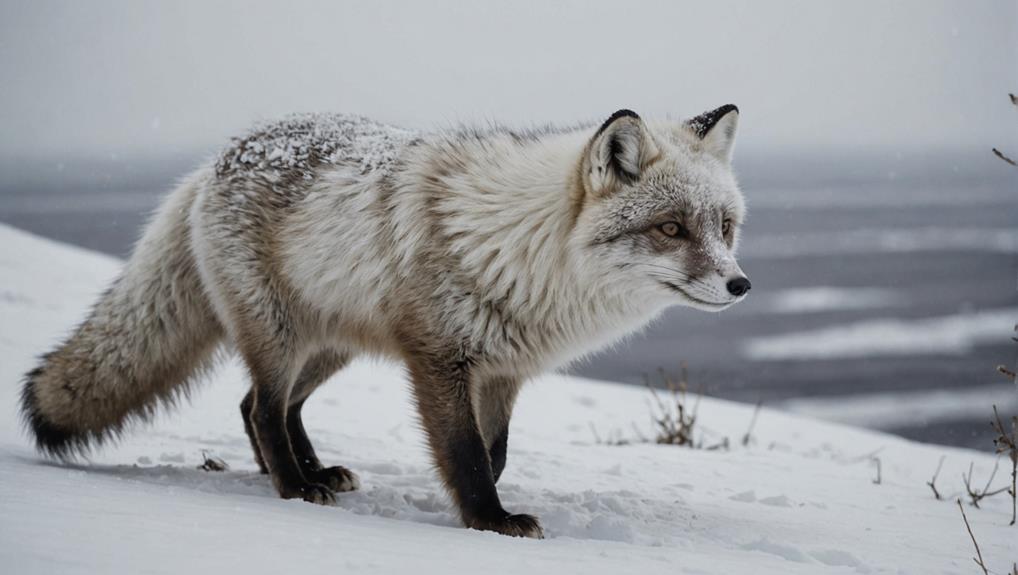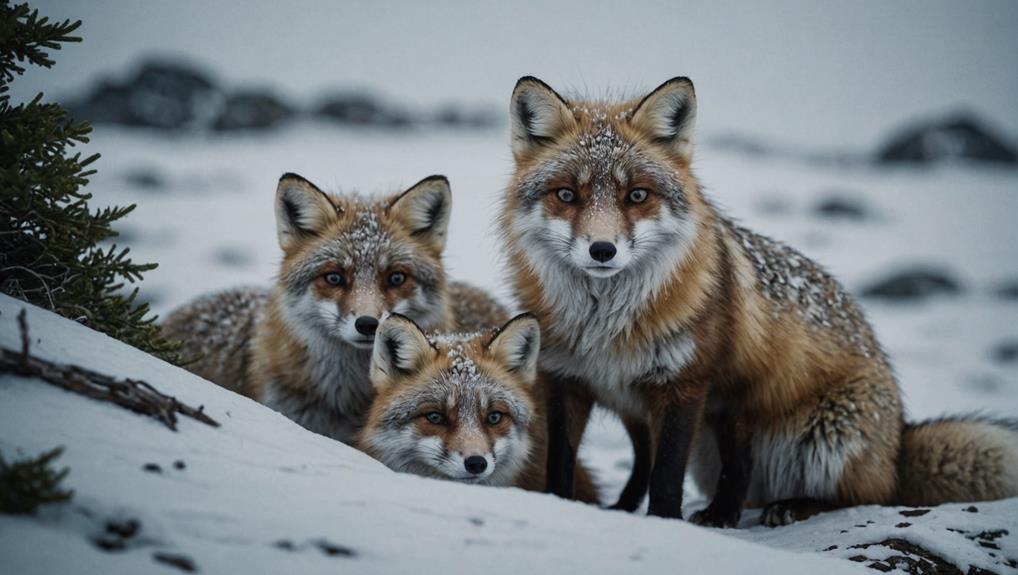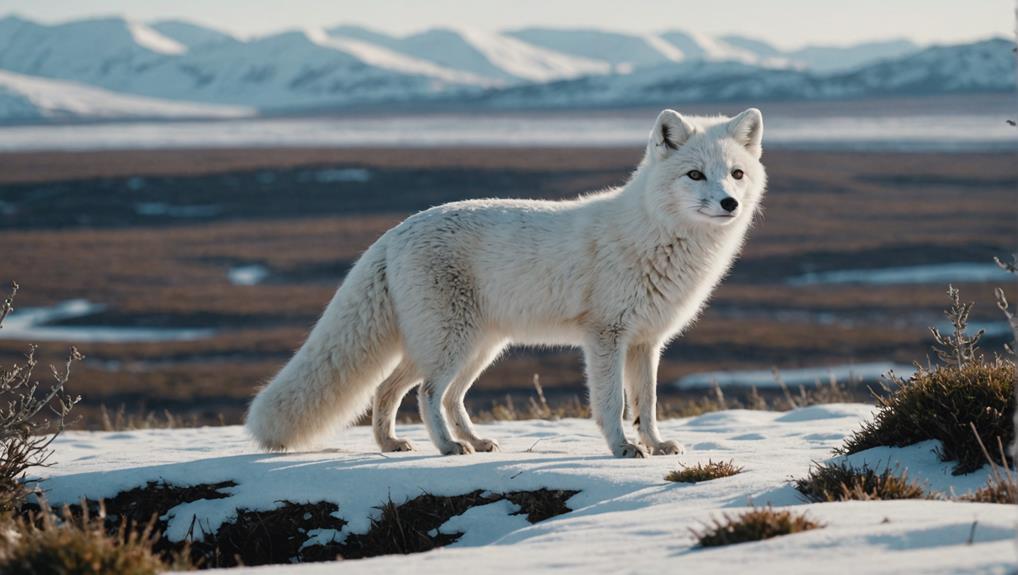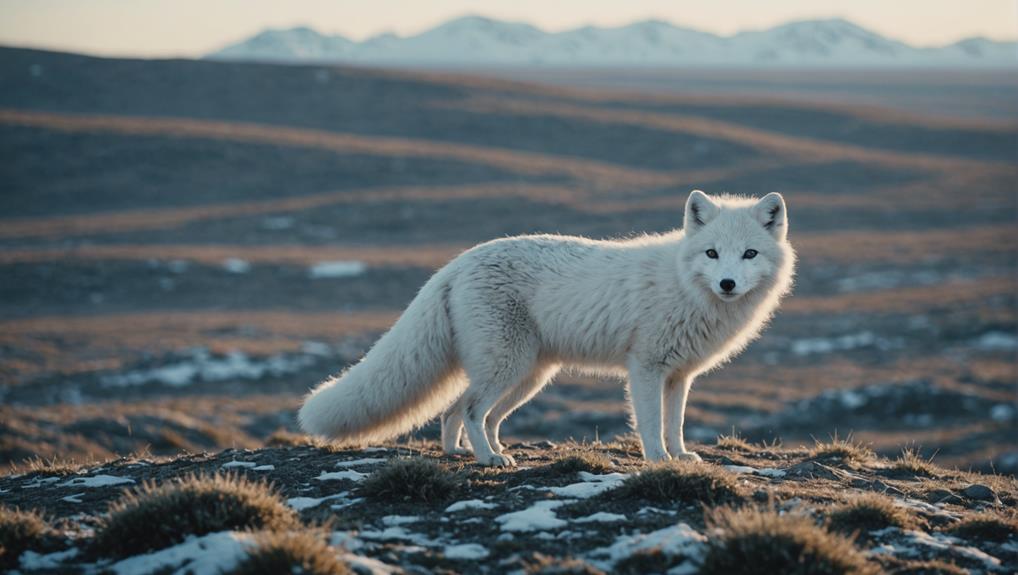Arctic foxes are extraordinary little survivors, perfectly adapted to their chilly tundra homes. With thick, warm fur that changes colors with the seasons, they blend in beautifully, whether it's winter white or summer brown. They curl up to keep cozy and even have furry soles that prevent slips on the ice. However, they're facing a tough time due to climate change, which is melting their habitats and threatening their food sources. It's a race against time for these clever critters. Stick around, and you'll discover even more about how they're coping in this ever-changing world!
Contents
Overview of Arctic Foxes
Arctic foxes, which are remarkable creatures of the tundra, thrive in some of the harshest environments on Earth. These small but resilient animals, averaging 20 to 24 inches in length and weighing between 6.4 and 8 pounds, are well adapted to their chilly surroundings.
With their thick, shaggy fur that changes color with the seasons, they blend seamlessly into the snowy landscape in winter and adopt darker hues in summer.
Living across the Arctic regions, from Alaska to parts of Northern Europe, these foxes play a vital role in their ecosystem. As key predators, they help control small mammal populations, keeping nature in balance.
Isn't it fascinating how such a tiny creature can make such a big impact?
However, climate change is shaking things up for our furry friends. As temperatures rise, their habitats are changing, and the delicate balance of the Arctic ecosystem is at risk.
Physical Adaptations for Cold
In the frigid landscapes where Arctic foxes roam, their physical adaptations are nothing short of extraordinary. These little furballs sport a thick fur coat that not only provides cozy insulation against icy winds but also changes color to white in winter. This clever camouflage helps them blend into snowy environments, making it easier to sneak up on dinner—or avoid becoming dinner themselves!
Arctic foxes are built compactly, with short legs, a short muzzle, and tiny ears. This design minimizes their surface area, helping them retain body heat like a snug blanket on a cold night.
You'll find unique furry soles on their feet, which not only prevent slipping on icy terrain but also reduce heat loss. When they curl up to rest, their round bodies trap warmth, making them little heat-saving machines.
As the seasons shift, their fur transitions from brown-gray in summer to winter white, enhancing their stealth. All these adaptations make Arctic foxes masters of survival in one of the planet's harshest climates.
Isn't it amazing how nature equips them to thrive in such a chilly world?
Behavioral Adaptations for Survival

Survival in the Arctic isn't just about physical traits; behavioral adaptations play a significant role too. Arctic foxes have some clever tricks up their furry sleeves to thrive in such a harsh environment.
For starters, when resting, they curl up tightly. This little move minimizes their body surface area, helping them conserve heat in extreme cold. Imagine wrapping yourself in a cozy blanket—it's pretty much the same idea!
These resourceful critters also build up large fat reserves when food is plentiful. This fat not only provides insulation but also serves as energy during tough times when the dinner bell isn't ringing.
Instead of hibernating, Arctic foxes stay active all year round, resting in their dens during harsh weather. It's like taking a snow day!
When food is abundant, they shift into social feeding mode, inviting friends over for a feast. Their behaviors even change with the seasons, influenced by temperature and daylight.
It's fascinating how they master thermoregulation! So, the next time you think of an Arctic fox, remember, it's not just about their fluffy tails; their smart behaviors are key to survival in the Arctic region.
Dietary Flexibility and Feeding
The Arctic fox's dietary flexibility is a key factor in its ability to thrive in one of the planet's most challenging environments.
You see, these clever little creatures have an omnivorous diet, munching on everything from small mammals like lemmings to birds, fish, and even berries. Their keen sense of smell lets them sniff out prey hidden beneath the snow or carrion from afar, making them expert foragers in harsh conditions.
Plus, they know how to play the long game. When food is plentiful, they cache extra prey to save for those lean winter months, ensuring they've got a snack handy when times get tough. It's like putting leftovers in the fridge—only much cooler!
These foxes also adapt their hunting techniques to the snowy landscape. You might catch them pouncing like furry little ninjas on unsuspecting prey buried under the snow.
Their opportunistic nature shines through when they scavenge from polar bear carcasses, showing just how resourceful they can be in the Arctic ecosystem.
Reproductive Strategies in Harsh Climates

Arctic foxes face unique challenges when it comes to reproducing in their harsh environment. They typically breed once a year, between April and June, giving birth to as many as 20 pups after a 52-day gestation. That's a lot of little furballs!
To ensure these pups survive, food availability plays a crucial role. If there's a good supply of prey, like lemmings, the foxes can raise larger, healthier litters.
During the breeding season, Arctic foxes form pairs and even share dens, showing us a wonderful sense of community. They all pitch in to care for the pups, making it a real team effort!
When food is scarce, these clever foxes have a trick up their sleeves: they cache food by burying extra prey. This ensures their young have something to munch on during weaning or tough times.
Climate Change and Habitat Impact
As you look at the Arctic fox, you might wonder how climate change is shaking things up for this furry little survivor.
Warming temperatures are shrinking their tundra homes, and with less snow, hunting becomes trickier—it's like trying to find your favorite snack in a messy kitchen!
Plus, with new competitors moving in and lemming populations dropping, these clever foxes face some tough challenges just to get by.
Warming Temperatures Effects
Warming temperatures in the Arctic have serious implications for the delicate balance of life there, especially for the Arctic fox. As the climate changes, these clever little creatures face habitat loss due to melting permafrost and decreasing snow cover.
You see, snow isn't just pretty; it helps Arctic foxes survive by providing camouflage while they hunt. Without it, they become easy targets for larger predators like red foxes, increasing competition for food.
Moreover, the warming climate can disrupt their seasonal behaviors. Imagine trying to keep track of when to breed or forage when the weather just won't cooperate! This unpredictability makes it tough for Arctic foxes to thrive.
And let's not forget about their main food source—those adorable little lemmings. As their populations dwindle, the Arctic foxes find themselves in a real pickle, struggling to find enough to eat.
To top it all off, habitat fragmentation from human activities makes it even harder for these foxes to roam and hunt.
Altered Prey Availability
Lemming populations are fluctuating dramatically due to climate change, and this shift poses a significant challenge for Arctic foxes. These clever little hunters rely heavily on lemmings for food, and when these prey populations dip, it's like a buffet closing early.
Increased temperatures and changing weather patterns are messing with the tundra ecosystem, making it tough for Arctic foxes to find their favorite snacks. As the snow cover melts away, these foxes lose their camouflage, making it harder to ambush their prey.
Imagine trying to sneak up on someone at a party when the music's too loud—frustrating, right? Habitat loss isn't helping either. With changing landscapes, finding reliable food sources becomes a scavenger hunt that even the best Arctic fox might struggle with.
To make matters worse, as prey species shift, Arctic foxes might've to change their hunting habits, which could lead to intense competition with other predators, like red foxes. It's a tough gig out there for these adorable creatures, and understanding their struggles can help us support conservation efforts to ensure their survival in this changing world.
Habitat Fragmentation Issues
Habitat fragmentation poses a serious threat to Arctic foxes, making their survival increasingly challenging. As climate change warms the Arctic, the snow cover these clever little hunters rely on starts to disappear.
This change makes it harder for them to blend into their surroundings, which is essential for sneaking up on their dinner. With fewer food resources, Arctic foxes find themselves competing more with larger predators, like red foxes, who also fancy a meal in this shrinking tundra.
Moreover, traditional prey populations, like lemmings, are disrupted by environmental shifts. This shift means Arctic foxes struggle to find enough to eat, impacting their health and survival rates.
To top it off, human activities, including industrial projects and pollution, are further breaking up their habitats. Imagine trying to find your way in a maze that keeps changing—frustrating, right?
Conservation Efforts for Arctic Foxes

Arctic foxes face numerous challenges due to climate change, but dedicated conservation efforts are making a difference.
You might be surprised to learn that these efforts focus on habitat protection and restoration, which is crucial for the survival of our furry friends. Organizations are standing up against oil drilling in vital Arctic regions, preserving essential habitats for foxes and other wildlife.
Community initiatives are also in full swing, working closely with Indigenous peoples to monitor fox populations and encourage sustainable practices.
Here are some key conservation efforts you should know about:
- Habitat Protection: Advocating for protected areas to ensure safe environments for foxes.
- Research Programs: Tracking how climate change affects fox distribution and behavior.
- Community Engagement: Partnering with local communities for sustainable practices.
- Educational Outreach: Raising awareness about the ecological importance of Arctic foxes.
Final Thoughts
So, next time you think of the Arctic fox, remember how tough these little critters really are! They've got some incredible adaptations to help them survive in icy conditions, but they still face big challenges from climate change. By understanding their struggles and supporting conservation efforts, we can help ensure these adorable foxes have a fighting chance. After all, who wouldn't want to see those fluffy tails trotting around the tundra for years to come?














